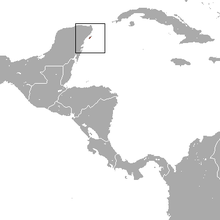The Cozumel emerald (Cynanthus forficatus) is a species of hummingbird in the "emeralds", tribe Trochilini of subfamily Trochilinae. It is endemic to the Mexican island of Cozumel off the Yucatán Peninsula.[4][3]
| Cozumel emerald | |
|---|---|

| |
| Scientific classification | |
| Domain: | Eukaryota |
| Kingdom: | Animalia |
| Phylum: | Chordata |
| Class: | Aves |
| Clade: | Strisores |
| Order: | Apodiformes |
| Family: | Trochilidae |
| Genus: | Cynanthus |
| Species: | C. forficatus
|
| Binomial name | |
| Cynanthus forficatus (Ridgway, 1885)
| |

| |
| Cozumel emerald range | |
| Synonyms | |
|
Chlorostilbon forficatus[3] | |
Taxonomy and systematics edit
The Cozumel emerald's taxonomic history is complicated. It was originally described as Chlorostilbon forficatus, then as a subspecies of golden-crowned emerald (now Cynanthus auriceps) which itself has been treated as a subspecies of Canivet's emerald (now Cynanthus canivetii). Other more recent authors include it and many other taxa as subspecies of the blue-tailed emerald (Chlorostilbon mellisugus).[5]
The North American Classification Committee of the American Ornithological Society, the International Ornithological Committee (IOC), and the Clements taxonomy assign it the binomial Cynanthus forficatus. However, as of 2020 BirdLife International's Handbook of the Birds of the World (HBW) retains it in genus Chlorostilbon.[6][4][7][3]
Description edit
Male Cozumel emeralds are 9 to 10.5 cm (3.5 to 4.1 in) long and females 8 to 9.1 cm (3.1 to 3.6 in). Males and females both weigh about 2.5 g (0.088 oz). Males have a black bill with a red tip. Its crown is bright golden to golden green and the rest of the upperparts a slightly duller golden green. Its underparts are brilliant metallic golden green with white tibial tufts. The tail is long and deeply forked, blue-black or black with a blue gloss, and the central two or three pairs of feathers have dark brownish gray tips. The female's maxilla is black and the mandible red with a black tip. Its upperparts are bright metallic green to bronze green. It has a white stripe behind the eye and blackish cheeks. Its underparts are light gray. Its tail is not as long or deeply forked as the male's. The central pair of feathers are metallic green to blue green and the next two pairs are the same color with a blue-black or black band near the end and white tips. The outermost two pairs have white outer webs at their base, a wide black band near the end, and white tips.[5]
Distribution and habitat edit
The Cozumel emerald is found essentially only on Cozumel Island of the coast of Mexico's Yucatán Peninsula. There is a single specimen from Isla Mujeres about 90 km (56 mi) north of Cozumel, and the species is thought to occasionally visit there. Authors have described its habitat as "scrub and low deciduous insular forest" and "brushy woodland and scrub, second growth".[5]
Behavior edit
Movement edit
The Cozumel emerald is a year-round resident of the island.[5]
Feeding edit
The Cozumel emerald's feeding strategy and diet have not been detailed. They are assumed to be similar to those of Canivet's emerald, which forages by trap-lining, visiting a circuit of a variety of flowering plants, and also feeds on small arthropods.[5]
Breeding edit
The Cozumel emerald's breeding season, nest, and other details of its breeding phenology have not been described.[5]
Vocalization edit
The Cozumel emerald's vocalizations are described as similar to those of it close relatives, "dry, rattling and chattering calls".[5]
Status edit
The IUCN has assessed the Cozumel emerald as being of Least Concern. It has an estimated population between 20,000 and 50,000 mature individuals that is believed to be stable. No immediate threats have been identified.[1] It is described as fairly common to common and "[h]uman activity probably has little short term effect on [the] Cozumel Emerald, which occupies edge and disturbed habitats."[5]
References edit
- ^ a b BirdLife International (2021). "Chlorostilbon forficatus". IUCN Red List of Threatened Species. 2021: e.T22724454A167033221. doi:10.2305/IUCN.UK.2021-3.RLTS.T22724454A167033221.en. Retrieved 26 November 2022.
- ^ "Appendices | CITES". cites.org. Retrieved 2022-01-14.
- ^ a b c HBW and BirdLife International (2020) Handbook of the Birds of the World and BirdLife International digital checklist of the birds of the world Version 5. Available at: http://datazone.birdlife.org/userfiles/file/Species/Taxonomy/HBW-BirdLife_Checklist_v5_Dec20.zip [.xls zipped 1 MB] retrieved 27 May 2021
- ^ a b Gill, F.; Donsker, D.; Rasmussen, P., eds. (January 2022). "Hummingbirds". IOC World Bird List. v 12.1. Retrieved January 15, 2022.
- ^ a b c d e f g h Arizmendi, M. d. C., C. I. Rodríguez-Flores, C. A. Soberanes-González, and T. S. Schulenberg (2021). Cozumel Emerald (Cynanthus forficatus), version 1.1. In Birds of the World (T. S. Schulenberg, Editor). Cornell Lab of Ornithology, Ithaca, NY, USA. https://doi.org/10.2173/bow.cozeme1.01.1 retrieved July 30, 2022
- ^ "Check-list of North and Middle American Birds". American Ornithological Society. June 29, 2021. Retrieved August 9, 2021.
- ^ Clements, J. F., T. S. Schulenberg, M. J. Iliff, S. M. Billerman, T. A. Fredericks, J. A. Gerbracht, D. Lepage, B. L. Sullivan, and C. L. Wood. 2021. The eBird/Clements checklist of Birds of the World: v2021. Downloaded from https://www.birds.cornell.edu/clementschecklist/download/ Retrieved August 25, 2021
